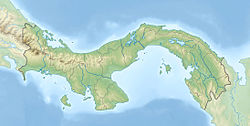| Escudo de Veraguas Formation | |
|---|---|
| Stratigraphic range: Piacenzian-Early Pleistocene | |
| Type | Formation |
| Unit of | Bocas del Toro Group |
| Overlies | Shark Hole Point Formation |
| Lithology | |
| Primary | Siltstone, sandstone |
| Location | |
| Coordinates | 9°06′N81°36′W / 9.1°N 81.6°W |
| Approximate paleocoordinates | 9°00′N81°06′W / 9.0°N 81.1°W |
| Region | Bocas del Toro |
| Country | Panama |
| Type section | |
| Named for | Isla Escudo de Veraguas |
The Escudo de Veraguas Formation is a geologic formation in Panama. It preserves fossils dating back to the Piacenzian to Early Pleistocene period. [1]
